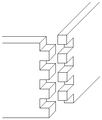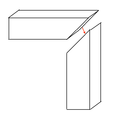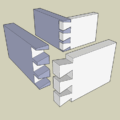Woodworking joints
Joinery often refers to the part of woodworking that involves the joining together of parts of wood.
Traditional wood joinery techniques use the distinctive material properties of wood, often without mechanical fasteners. There are different types of joinery for different structures, for example the joinery used to build a house is different from that used to make puzzle toys, although elements overlap.
Wood is strong when stressed along the grain (longitudinally), but weak across it (radially and tangentially). It expands and contracts in response to humidity. This change is very small longitudinally. It is considerable, but unequal, in the radial and tangential directions.
Glue is highly effective for joining wood when both surfaces of the joint are edge grain. A properly glued joint may be as strong as a single piece of wood. However, glue is ineffective on end-grain surfaces.
Images of different types of joints
Styles of Joinery
Two of the most common traditions of joinery are Japanese and European. The Japanese in particular developed hundreds of types of joints and their furniture was often held together without glue or nails.
Other pages
References
- Bernard Jones (Ed.) (1980). The Complete Woodworker. ISBN 0-89815-022-1
- Peter Korn (1993). Working with Wood. ISBN 1-56158-041-4
- Sam Allen (1990). Wood Joiner's Handbook. Sterling Publishing. ISBN 0-8069-6999-7
- Wolfram Graubner (1992). Encyclopedia of Wood Joints. Taunton Press. ISBN 1-56158-004-X




